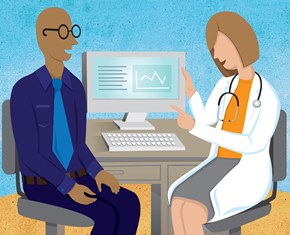
Over the past few decades, numerous methods to improve patient engagement increase patient activation have popped up. This includes using patient portals and HIPAA compliant email.
RELATED: HIPAA Stands For . . .
Researchers believe that increased patient engagement directly correlates with patient involvement. And increased patient involvement means better patient care. Covered entities (CEs) must utilize the best channel of communication that is also HIPAA compliant. Although both patient portals and email have their merits, ultimately HIPAA compliant email is a safer, simpler, and more effective communication tool.
Importance of patient engagement
Patient engagement involves the interaction between patients and CEs. Studies show that more involvement (i.e., patient activation) means better health outcomes and, more than likely, lower costs. According to a 2019 NEJM Catalyst Insights Council survey, 59% of patients believe effective patient engagement strategies have an impact on their healthcare. And if patients believe it, then finding the most effective communication methods must be important. Moreover, CEs are figuring out that patients want to be more engaged in their health. And they want a lasting relationship with their caregivers. Other methods of communication, besides email or portal systems, can be through mail, telephone/texts, and/or mobile applications (apps).
RELATED: VoIP Providers and HIPAA Compliance: The Ultimate Guide
For CEs the best techniques balance easy access with HIPAA compliance. That is, creating patient engagement while also avoiding data breaches and possible HIPAA violations. Patient portals began because of this balancing act.
RELATED: Healthcare Data Breaches – A Haunting Reality
What are patient portals?
Patient portals, created over 15 years ago, are healthcare-related online apps that allow patients to securely communicate with healthcare providers while safeguarding patients’ protected health information (PHI). The idea is that these portals are accessible only by patients and CEs, anywhere and at any time. Through portals, patients can:- Message a doctor
- Access their own PHI
- Request prescription refills
- Pay bills
- Book appointments
- Download and complete forms
- View educational materials
- Receive health-related reminders
Not all patient portals perform the same functions. At the very least, these systems let patients communicate without fear of exposing their PHI.
Patient portals, security, and engagement
We first addressed portal security in 2016 and concluded: having a portal does not necessarily mean more protection. For example, we often see email portals that use the same encryption methods as Paubox does with our HIPAA compliant email products.
RELATED: Paubox Eliminates Obsolete TLS Protocols, Follows NSA Guidance
How portals differ has to do with means of access. Portals ask patients to open a new website or download an app and then create a new login to access a separate system with a separate password. In 2018, there was a push to use patient portals, but patients weren’t signing up or signing in. The Association of Health Care Journalists referred to portals as “dead zones.” By 2019, 62% of surveyed CEs said that less than one-quarter of their patients were registered on their portals. And those that were registering thought portals were only using them to make appointments. Today, nearly all CEs offer some type of patient portal even though patients still seem wary of using them. The potential is there, but problems with access and engagement outweigh positive outcomes. If patients don’t want to interact through a portal, such systems are useless.
Why email works better than patient portals
Studies have indicated that patient engagement through email improves patient outcomes. More than 1 in 3 patients reported that email correspondence with their doctor avoided them from having to call the doctor's office or come in for a visit, and nearly one-third of patients reported that emailing with their provider improved their overall health. In addition, 93% of patients want to email their doctors. After all, people are used to communicating via email, not via a patient portal. Health emails can yield unique open rates as high as 60%, compared to a 20% average open rate for marketing emails.How Paubox can help
Rather than fight and fuss with portals, CEs should turn to HIPAA compliant email with Paubox Email Suite for their communication needs. Why? Because Paubox Email offers security and HIPAA compliance but provides easier access and simpler communication with patients than an email portal. Paubox Email Suite works on every type of device so patients can always be in contact. There is nothing to download or accounts to create. No extra passwords to remember. No extra clicks or web pages to wade through to get to a place where a patient can find their PHI. With our HITRUST CSF certified solution, all emails are encrypted and sent directly from your existing email platform (such as Microsoft 365 and Google Workspace). With Paubox Email Suite, CEs can effectively care for their patients and engage them in their health outcomes. All while remaining safe and secure.Subscribe to Paubox Weekly
Every Friday we'll bring you the most important news from Paubox. Our aim is to make you smarter, faster.




